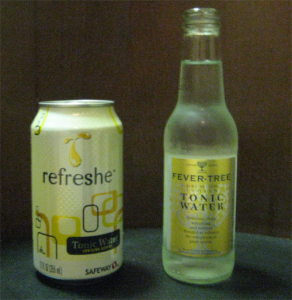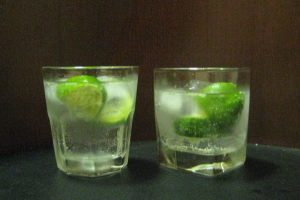Last year I was introduced to high end tonic water by our friends Josh and Sarah with whom we have tasted before. I remember the higher quality tonic water being much better than the usual stuff we get from Safeway or CVS. We invited Gayle and Zach over to figure out whether it is indeed worth the extra money.
We picked up Fever Tree brand tonic water for $6 (or $1/mini bottle) and decided to compare it to the cheapest tonic around, Safeway’s tonic in a can ($1.50/6 pack).
We made two identical gin and tonics with Beefeaters (it’s what we had).
We passed them around.
Gayle thought that the one made with Safeway tonic (we’ll call it the “economy tonic”) tasted like what a gin and tonic should taste like. “Oooh interesting,” she said as she tasted the other (we’ll call it the “Fever Tree tonic”), “there’s not as much difference as I thought there’d be.”
Zach liked the Fever Tree tonic better because the flavors were more balanced, and overall it was less sweet. “It complements the flavor of gin rather than competing with it.”
Will took his time tasting, as he’s wont to do. “I don’t know,” he sighed. “I don’t notice as much as a difference as I thought I would.” When pressed, he thought that the Fever Tree Tonic was more bitter, consistent with Zach’s findings.
Upon a second tasting, Gayle noticed different after tastes from the two drinks. She and I spent awhile reminiscing about the terrible gin and tonics we have had at bars. Sometimes they don’t clean the hoses or run out of the tonic syrup without realizing it. We have returned gin and tonics from time to time; we’ve always had a bit of cocktail snobbery in us.
I agreed with Gayle that the gin and tonic made with economy tonic tasted the way we have come to expect a gin and tonic to expect. When compared with the Fever Tree tonic, though, I noticed a bit of a metallic taste to the economy tonic. Perhaps due to it being stored in a can? Other than that, though, the difference was not nearly as palpable as I remembered it!
Perplexed by our findings, we poured straight tonic into glasses and tasted that. The verdict was the same.
The Fever Tree tonic is better, has a bit more depth and complexity, but for six times the price, it does little to add to a mixed drink.
{ 0 comments }












